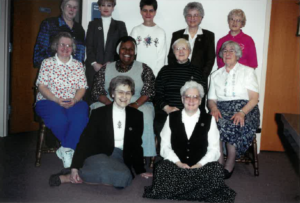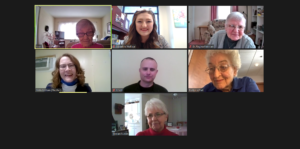Celebrating 20 Years of Serving Men Experiencing Homelessness
The roots of Joseph’s Home were planted in 1851 when the Sisters of Charity of St. Augustine (CSA) arrived in Cleveland from France to serve as the city’s first public health nurses. The first CSA sisters quickly went to work serving the health, human service and educational needs of Cleveland’s most impoverished and vulnerable residents, and have been doing so ever since.
The Dream Team
 In the mid-1990s, the Sisters of Charity of St. Augustine established “The Dream Team”—a group of eight CSA sisters—to create proposals for projects to respond to a variety of pressing societal needs.
In the mid-1990s, the Sisters of Charity of St. Augustine established “The Dream Team”—a group of eight CSA sisters—to create proposals for projects to respond to a variety of pressing societal needs.
Sister Ruth Ann Patrick, CSA, a social worker at St. Vincent Charity Medical Center, discussed the needs of those experiencing homelessness who had been discharged from the hospital with nowhere to stay to recover from illness and/or surgery. This need quickly captured the passion of the committee and they began to develop a vision of how to respond. The Dream Team eventually selected a site and evaluated funding opportunities. A board of directors was appointed in October 1999. Sisters Joan Gallagher, CSA, Regina Fierman, CSA, Theresa Bontempo, CSA, and Evelyn Flowers, CSA, were among the founding members.
Sr. Joan became executive director in early 2000. Sr. Regina, a certified occupational therapy assistant and member of the original Dream Team, joined the staff as house monitor and resident educator. Participation by the Sisters of Charity of St. Augustine on the Joseph’s Home Board of Directors continues to this day, with Sr. Mary Dorothy Tecca, CSA, currently serving.
On August 3, 2000, the first resident arrived. Since that day, hundreds of men have passed through the doors of Joseph’s Home.
A Conversation with Members of the Dream Team

In celebration of Joseph’s Home’s 20th Anniversary, several members of the Dream Team shared a look back at the early days of Joseph’s Home and their hopes for the years to come in a virtual discussion with Executive Director Beth Graham.
Q: Can you tell us a bit about your involvement with the idea to start Joseph’s Home more than 20 years ago?
A: Sr. Evelyn Flowers, CSA – I keep thinking back to the day when I first heard of the need. I was so angry that this should be happening in our country. I like to think of that as a Holy Spirit moment because of the way it grabbed everybody, and because of the way it just developed from there and everybody stuck with it.
A: Sr. Joan Gallagher, CSA – At the time, I was working for Famicos Foundation as the associate director and had some background in housing. I was asked to take the lead on Joseph’s Home, so I left Famicos in 1998. The Sisters of Charity Health System gave me an office and many individuals there offered to help with this or that. One day, I was struggling with the development of the budget to submit for a grant. Out of the clear blue, one of the guys came in and said, ‘Give me that, I’ll have it done in an hour.’ And sure enough, comes back with the budget completely filled out how it was going to be projected for five years. That’s just one example of how helpful health system employees were.
A: Sr. Regina Fierman, CSA – I was an occupational therapy assistant, working in rehab at St. Vincent Charity. I went to rooms to make sure patients could take care of themselves, which included being able to get up and get dressed and do all of the daily things. I went into one gentleman’s room. I introduced myself and told him I was there to work with him. He absolutely refused to do it. I kept trying and it was the same thing. Then it dawned on me. This guy was homeless. He had a bed to sleep in, three meals a day and medical care. If I documented that he could do what he needed to do, he would be out the door. So that kind of planted the seed with me as far as Joseph’s Home.
A: Sr. Ruth Ann – As a community, we were just feeling challenged to start thinking outside of the box about what the needs of the community were. We were pitching a lot of ideas that were going on flipcharts. I was a social worker at Charity Hospital. The homeless, particularly the men, would come in but would only be able to stay for a certain amount of time. In the homeless shelters, they could stay overnight, but had to leave early the next day. When I gave the example of someone who had broken their ankle, was in a cast and they needed to find shelter. Or someone who needed to have daily wound care, but not enough that it warranted a nursing care facility. This inspired the sisters to think about what they could do. We formed a committee. The earliest task I did was to send letters to social workers in the community at hospitals and in shelters asking about the need for something like Joseph’s Home. I received their responses back saying that “yes, we need this,” and that this would definitely fill a gap in the community.
Q: What was it like in those first few years when you were just getting started?
A: Sr. Evelyn – I remember the whole dream team group doing a lot of foot traveling, going around visiting other small endeavors. How did they do it? How did they run it? How did they get their people? How did they serve them? So we did a lot of that—to add to our knowledge. Once we got going, we had to give it up to the health system while still keeping our fingers in the pie. It was kind of like giving up a baby, but that was okay. The health system really is what enabled the whole thing to keep going.
A: Sr. Joan – They were years of learning, developing policies and hiring the right persons, or at least we thought we were hiring the right persons, creating a board, hiring our nurse. We had to be flexible and willing to do whatever was needed to keep the ministry going.
A: Sr. Regina – With staffing in the beginning, we were helping to cover shifts where needed. That could mean working a weekend or covering the night shift or doing whatever. We were really challenged to keep things up and running, but we were able to do that.
Q: How did the residents in those early days view Joseph’s Home?
A: Sr. Joan – This is not Joseph’s house, this is Joseph’s Home. Everybody in our home has a responsibility to make it a home. Residents had to do dishes and clean up the dining room. Many of the guys would tell us it was the first time in their life they had a room of their own. They didn’t have to worry about where their meal was going to come from or who they might fight with. That kind of attitude certainly encouraged us to continue the work.
A: Sr. Regina – One of the things that I tried to instill that this was not a shelter. You’re not here to just sleep and get a meal and then be back on the streets. Know that we’re here to work with you to get you back on your feet and allow you to heal. That stuck with me from the very beginning—this is not a shelter, it’s a home. Also, part of the Ministry of Joseph’s Home is to listen to their [resident] stories. That’s when you really get to know the person. That was one of the blessings of working with residents. You’ve heard their stories and they were grateful that you listened to them.
Q: What are you most proud of when looking back?
A: Sr. Joan – We have served over 650 guys. If I’m correct on this, more than 80 percent of them are succeeding in their present situation as alumni—medically stable, have housing and are financially able to meet their needs. That is remarkable. It’s not only the mission, but because the Joseph Home staff have prepared the guys for the future. That is something that’s very difficult to do because you have to change a whole way of living.
A: Sr. Regina – CSA has always been risk takers and called to meet the needs of the times. Joseph’s Home really is a success story and an answer to God’s call to serve the most vulnerable.
A: Sr. Ruth Ann – I am most proud that our vision was just a spring board. Now look at what Joseph’s Home is today. I really am proud of men being able to turn their lives around. I am truly amazed seeing how the Holy Spirit continues to lead that ministry and directs all of the people who have answered the call to be a part of the ministry, carrying on the call of the CSA’s ministry. What we see every day is really miraculous.
Q: What do you hope for the future of the ministry?
A: Sr. Evelyn – This is a service to those who are on the fringes, as they say. And when we talk about where does the church go from here, we keep hearing to pay attention to the people who are on the fringes, that’s where you’re really needed. Any of us can happen to be on the fringes at some time, so that’s the kind of people who really need a lot of help.
A: Sr. Marian Durkin, CSA – I’m very excited about the possibility of expanding services to women with Mary’s Home. How wonderful that Joseph’s Home is successful so that we’ve got that base and we know how to do it.
A: Sr. Joan – When we first started, I believed and prayed that we would be able to go through one year at a time. When I think about the future, it really is as long as the need is there. My hope is that at some point we won’t need a Joseph’s Home, but I don’t see that happening. As long as shelter is needed and 2100 is there for short-term shelter [men’s shelter at 2100 Lakeside Ave.], there will be a need for a medical respite shelter like Joseph’s Home and Mary’s Home for women.
A: Sr. Ruth Ann – I hope that it can keep on growing and that it continues to spark life into our homeless population. I hope the life it sparks into Joseph’s Home will bring about new life in Mary’s Home. I hope that dream becomes more of a reality. I think that would be wonderful.


